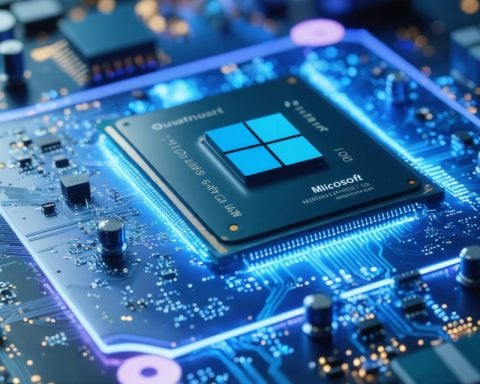- UC Santa Barbara and Microsoft have developed an eight-qubit topological quantum processor, marking significant progress in quantum computing technology.
- The processor is based on a new state of matter called a topological superconductor, which features Majorana zero modes that enhance error resistance.
- Qubits in this system leverage anyons, which operate within a superconducting nanowire, providing superior stability and power over traditional systems.
- This advancement is the result of a collaborative effort, blending theoretical insights with material science to build a functional topological quantum chip.
- The development signifies a step towards achieving a reliable and efficient quantum future, with enhanced speed and accuracy in computation.
- The project underscores the potential of topological quantum computing, pushing humanity closer to realizing quantum computing dreams.
Amid the rolling hills of Santa Barbara, an electric surge of progress unfurled: an eight-qubit topological quantum processor, crafted by a collaboration of brilliant minds led by UC Santa Barbara physicists and Microsoft’s elite. This exquisite marvel is no ordinary chip. It’s a manifestation of a vision long held secret, now lighting the path toward the elusive topological quantum computer.
The heart of this breakthrough lies in a new state of matter: the topological superconductor. Picture strands of energy intertwined, giving birth to exotic boundaries known as Majorana zero modes. These intricate creations whisper promise into the future of quantum computing—robust and immune to errors plaguing traditional systems.
In this realm, qubits transcend binary existence, dancing in between states, powered by the mystical anyons. These entities weave through a superconducting nanowire like ancient artisans, crafting a tapestry woven with unparalleled stability and power.
Microsoft’s team, fueled by collaborative spirit, has cracked a code encoded within the very structures of matter. With ingenuity akin to a symphony, they have brought the blueprint to life, plotting a course for tangible topological computation.
Yet, beyond the immediate technical feats, the essence of this project is the symbiotic fusion of theory and material science. Masters of their crafts lent hands and minds, stitching together precise compounds and methods that make this achievement not just possible, but inevitable.
In the serene echo of Santa Barbara’s coastline, a new dawn of quantum mechanics arises. As topological processors begin their reign, humanity edges ever closer to harnessing quantum mystique—achieving speed, accuracy, and dreams once deemed impossible. Here lies the promise: a quantum future securely tethered in reality’s embrace.
Revolutionizing Computing: The Topological Quantum Leap
Introduction
The development of an eight-qubit topological quantum processor by UC Santa Barbara physicists and Microsoft represents a significant advancement in quantum computing technology. This innovative processor utilizes topological superconductors, featuring robust qubits stabilized by Majorana zero modes and anyonic particles for unparalleled computations. This breakthrough is pivotal for the future of quantum computing, promising enhanced stability and error resistance not achievable by traditional methods.
Features, Specs & Pricing
Features
– Topological Superconductors: Offer a new state of matter which facilitates the existence of Majorana zero modes, crucial for stable quantum operations.
– Anyonic Particles: Enable qubits to exist in superposition and entanglement states, essential for complex quantum calculations.
– Error Robustness: Architecture inherently resists decoherence, a major advancement over traditional quantum systems.
Specifications
– Qubit Count: Eight-qubit processor
– Technology: Superconducting nanowires
– Performance: Enhanced error correction and stability
– Collaboration: Developed in collaboration between UC Santa Barbara physicists and Microsoft’s research team
Pricing
– Cost: Quantum processors are typically part of larger systems and are not priced individually; the cost depends on the scale and application of the technology in integrated quantum computing systems.
Real-World Use Cases
– Cryptography: Topological quantum processors have the potential to break current cryptographic codes and establish unbreakable encryption protocols.
– Material Science: Simulation of complex molecules and materials, allowing for accelerated discovery of new compounds.
– Optimization Problems: Solving complex optimization issues in logistics and supply chain management, leading to more efficient resource allocation.
Market Forecasts & Industry Trends
According to Gartner, the quantum computing market is expected to reach $5-$10 billion by 2025, driven by advancements such as topological quantum processing. Firms like IBM, Google, and Microsoft are making significant investments, indicating a shift towards commercial quantum computing applications.
Reviews & Comparisons
In comparison to traditional quantum processors, topological quantum processors are predicted to offer:
– Improved Error Rates: Thanks to their topological nature, leading to fewer operational errors.
– Enhanced Scalability: More qubits can be added without exponentially increasing the noise and error rates.
– Greater Computational Efficiency: Ability to maintain coherence over longer durations, enhancing the breadth of calculations.
Controversies & Limitations
Controversies
– Feasibility and Practicality: Some skeptics argue about the real-world applicability and potential overhyping of topological quantum processors.
Limitations
– Technical Challenges: Integration with existing technologies and solving specific interface issues remain challenging.
– Scalability: While theoretically superior, scaling the current eight-qubit design to thousands of qubits necessary for practical applications presents significant hurdles.
Security & Sustainability
– Security: Offers a pathway to quantum-safe algorithms, crucial for protecting sensitive data in the quantum era.
– Sustainability: Potential to reduce the energy footprint of data centers by solving complex problems efficiently.
Insights & Predictions
As quantum computing technology matures, topological quantum processors are expected to become pivotal in industries like pharmaceuticals for drug discovery, finance for risk modeling, and energy for optimizing grid management.
Actionable Recommendations and Quick Tips
1. Stay Informed: Follow developments in quantum computing through reputable sources like IBM and Microsoft.
2. Explore Partnerships: Tech companies can explore collaborations with academic institutions to access cutting-edge quantum technologies.
3. Invest in Education: Build expertise in quantum algorithms and topological insulators to stay ahead in this rapidly evolving field.
This landscape holds transformative potential, and by understanding and leveraging quantum advances, industries can prepare for a computing future that was once science fiction.













